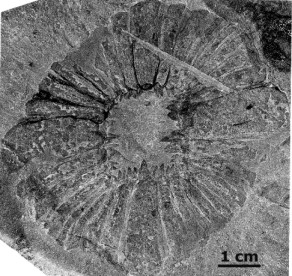A brief history of anomalocarid studies
and reconstructions:
In 1892 Whiteaves described a spine-bearing
segmented fossil from the Mt Stephen trilobite beds in the Canadian Rockies
as the abdomen and tail of a phyllopod crustacean. He called it Anomalocaris
canadensis, noting in its generic name that it was an "anomalous shrimp,"
since it showed no sign of a gut, and its ventral, spine-like "appendages"
were unsegmented. Subsequently, this and other parts of what we now call
Anomalocaris and Laggania have been variously described
as a jellyfish, a sea cucumber, a polychaete worm, a composite of a jellyfish
and sponge (Conway Morris 1978), or have been attached to various other arthropods,
real or conjectural (e.g., Henricksen 1928, Briggs 1979).
| Isolated anterior appendages
of Anomalocaris were initially interpreted as the bodies of shrimp.
CG images courtesy David Quinn 

|
Peytoia (the mouth
of Anomalocaris) was named and described by Walcott (1911) as a sort
of jellyfish.


|
Laggania was interpreted
initially as a sea cucumber. 
|
Meanwhile, in 1928, an
incorrect "head" for Anomalocaris was proposed via the carapace of
a crustacean called Tuzoia. 
|
Charles D. Walcott collected complete specimens of Anomalocaris nathorsti [now Laggania cambria] prior to 1917, and the Geological Survey of Canada collected a nearly complete specimen of Anomalocaris canadensis in 1967. These were among many Burgess specimens that received little attention until the advent of the 1980s. This was a time of major revelation on the true nature of Anomalocaris...
Continue with the story of Anomalocaris...